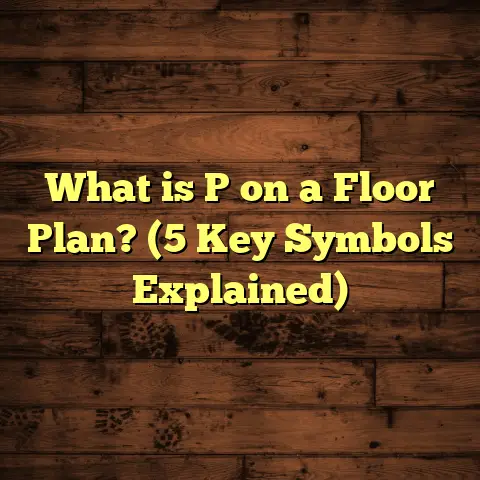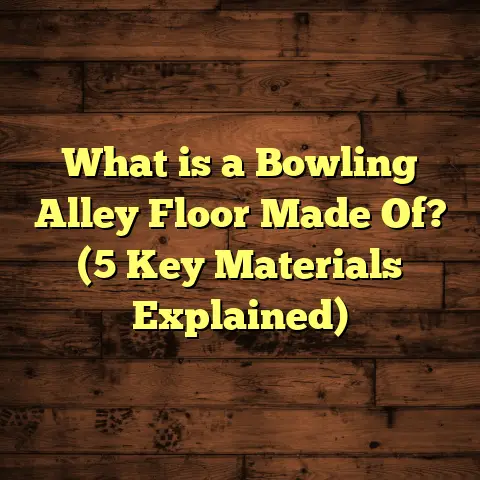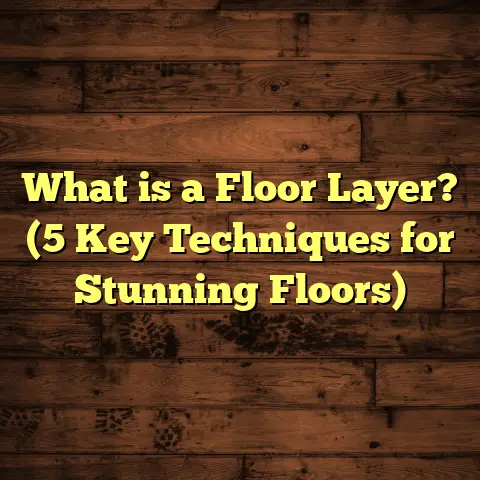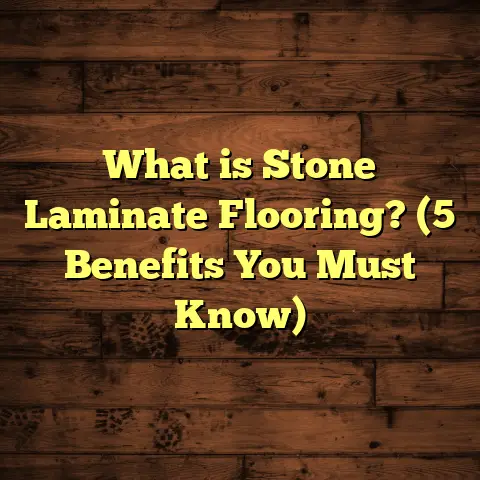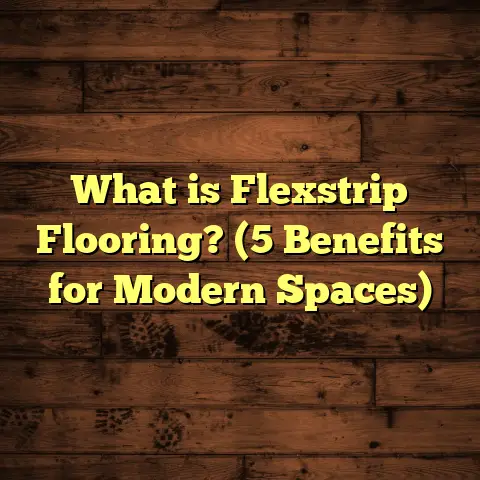What is Self-Leveling Epoxy Flooring? (5 Benefits for Your Home)
Have you ever stepped into a space where the floor looks so smooth and flawless it almost seems unreal? Maybe it gleams like glass under your feet or reflects light in a way that makes the entire room feel brighter. What if I told you that floor wasn’t just beautiful but also incredibly tough and easy to maintain? If you haven’t encountered self-leveling epoxy flooring yet, you’re in for a surprise. I want to share everything I’ve learned after years of working closely with this material—how it works, why it’s become so popular, and how it could be perfect for your home.
What is Self-Leveling Epoxy Flooring?
The phrase “self-leveling epoxy flooring” might sound technical at first. Let me break it down…
Epoxy itself is a chemical compound made from two parts: resin and hardener. When these two mix together, they undergo a chemical reaction that transforms the liquid mixture into a solid plastic-like coating. This coating forms an incredibly strong bond with the surface underneath it—usually concrete.
Now, “self-leveling” means that when you pour the epoxy mixture onto a floor, it naturally spreads out evenly without much effort. Unlike traditional epoxy coatings that may require spreading or troweling to smooth them out, self-leveling epoxy flows like thick syrup, filling cracks and low spots before curing into a perfectly uniform layer.
This quality is especially useful on floors that aren’t perfectly flat. Say you have a basement with uneven concrete or a garage floor with minor dips and cracks—self-leveling epoxy can smooth over these imperfections without needing additional expensive grinding or patching.
The Chemistry Behind It (But Not Too Deep!)
I’m not going to get too scientific here because I know that can be overwhelming. But understanding the basics of how this stuff works helped me appreciate why it’s so effective.
When resin and hardener mix, they start what’s called a polymerization process—a chemical reaction where small molecules link up into long chains forming a solid structure. This makes epoxy resistant to water, chemicals, and physical wear.
Self-leveling epoxies typically have additives that adjust their viscosity, meaning how thick or runny they are. These additives allow the mixture enough fluidity to spread evenly but still dry quickly to a hard finish.
Different From Regular Epoxy
Not all epoxy floors are self-leveling. Some are thicker and need to be spread manually, which can lead to uneven surfaces or visible brush strokes. Self-leveling variants are formulated to solve these problems by flowing out smoothly on their own.
My First Encounter with Self-Leveling Epoxy Flooring
Let me share when I first came across this amazing flooring option.
Years ago, I worked on a commercial project where the client needed a floor that could withstand heavy machinery but still look polished enough for customers visiting the showroom.
Traditional epoxy coatings were too rough and uneven for the aesthetic they wanted. That’s when I suggested trying self-leveling epoxy as an experiment.
The results blew me away.
Not only did the floor look like polished stone with its mirror-like finish,
but it was also incredibly durable.
That project opened my eyes to all the possibilities for residential use too.
5 Benefits of Self-Leveling Epoxy Flooring for Your Home
After installing hundreds of floors and chatting with clients,
I can confidently say these five benefits stand out:
1. Beautiful, Seamless Surface That Can Be Customized
One of the biggest draws is how stunning the floor looks. It’s smooth all over—no seams, no grout lines like tiles, no cracks like concrete.
You can literally create any look:
- Solid colors that pop
- Metallic finishes that shimmer under light
- Embedded patterns or logos for personalization
- Decorative flakes for texture and sparkle
I remember a homeowner who wanted something unique for her art studio floor. We mixed in blue and green flakes that resembled ocean waves—she said it inspired her creativity every time she stepped in.
The finish is glossy but not slippery if done right,
and it reflects natural light beautifully,
making rooms feel larger and brighter.
2. Incredible Durability and Resistance
Having dealt with different flooring materials,
I’ve seen firsthand how self-leveling epoxy stands up against abuse.
It resists:
- Scratches from furniture or pet claws
- Stains from food, oil, or chemicals
- Cracks due to temperature changes or settling concrete
In fact, one industrial study showed epoxy floors maintain their integrity under compressive loads exceeding 10,000 PSI—which is far beyond what residential floors experience.
This means longevity—floors installed today can serve you well for decades if cared for properly.
3. Maintenance Is Simpler Than You Think
I won’t lie: some floors require hours of scrubbing or special cleaners.
Epoxy floors? Nope.
I tell clients to sweep or dust mop regularly,
and mop occasionally with warm water plus mild detergent.
No waxing or polishing needed.
And because the epoxy seals the underlying concrete,
it blocks moisture and dust from seeping in—
which keeps your home cleaner overall.
I once helped a family with allergy issues switch their carpets for epoxy floors,
and they noticed fewer allergy flare-ups almost immediately due to less dust trapped inside the home.
4. Installation That’s Faster Than Other Flooring Options
Time is money—especially if you’re renovating while living in your home.
Self-leveling epoxy installation usually takes 2-3 days total:
- Day 1: Surface preparation (cleaning and repairing cracks)
- Day 2: Pouring and leveling epoxy mixture
- Day 3: Final curing and finishing touches
Compare this to hardwood floors which can take over a week to install properly,
or tile where grouting adds extra days,
and you see why many homeowners opt for epoxy when speed matters.
5. Budget-Friendly Over the Long Term
While self-leveling epoxy might seem pricey initially,
consider its lifespan and minimal maintenance needs—
these save money over time.
Costs vary widely depending on quality and design:
- Simple solid colors start around $3-$5 per sq ft
- Complex metallic or decorative finishes range $8-$12 per sq ft
For comparison,
hardwood floors average $8-$15 per sq ft installed,
while tile can go $10-$20 per sq ft depending on materials.
I always use FloorTally when planning projects now because it helps me estimate costs accurately based on local labor rates and material prices.
It even factors in waste percentages so I avoid ordering too much material—a common source of wasted budget otherwise!
This tool saves me time and helps clients avoid surprises during installation.
The Detailed Installation Process: What Happens Step by Step?
If you’re thinking about trying this yourself or just curious about how it’s done,
here’s a breakdown:
Step 1: Inspection and Surface Preparation
This is critical.
Epoxy only works well when applied to clean,
dry concrete without oils or contaminants.
I spend hours grinding or shot blasting the surface to remove old coatings or sealants,
then vacuum everything thoroughly.
Any cracks or holes are filled with patch compounds compatible with epoxy.
If moisture levels in concrete are high (which can cause bubbling),
I recommend moisture barriers before application.
Step 2: Mixing The Epoxy
Mixing has to be precise:
The resin and hardener ratios must be exact to avoid sticky spots or uneven curing.
Many brands provide pre-measured kits which simplify this step.
Once mixed,
the pot life (workable time) is limited—usually 20-30 minutes,
so everything must be ready before pouring.
Step 3: Pouring And Leveling
This is where the magic happens:
The mixed epoxy is poured onto one edge of the floor,
then spreads naturally across the surface due to its fluidity.
I use spiked rollers to help release bubbles trapped inside the mixture while leveling it gently with squeegees if needed.
The self-leveling property ensures no trowel marks remain,
and thickness stays uniform (usually between 1/8” to 1/4”).
Step 4: Curing And Finishing
Curing time depends on temperature/humidity but usually takes 24-48 hours for light foot traffic,
and up to 7 days for full chemical resistance or heavy use.
During curing,
it’s important to keep dust and debris away from the surface.
Some installers add a clear topcoat for extra gloss or UV protection,
although many self-leveling epoxies come pre-formulated with these properties already.
Real-Life Case Study: Kitchen Renovation Success Story
A few years ago,
a client wanted to renovate her kitchen floor without removing existing tiles which were cracked and outdated.
We suggested applying self-leveling epoxy directly over the tiles after proper surface prep.
This saved time and demolition costs while delivering a beautiful new look.
Here’s what happened:
- The project took three days total; no major disruptions for her family during installation
- The final floor was smooth with a high-gloss beige finish that brightened the whole kitchen
- The kitchen became easier to clean after cooking messes compared to before
- She reported zero damage even after dropping heavy pots several times
That project convinced me how versatile self-leveling epoxy can be—not just for new builds but also renovations where budgets or timelines are tight.
What About Environmental Impact?
People ask me if epoxy flooring is eco-friendly since it involves chemicals.
Here’s what I’ve learned:
Modern epoxies have low volatile organic compound (VOC) emissions which reduces indoor air pollution during installation compared to older products.
Plus,
because they last so long without needing replacement,
you reduce landfill waste compared to disposable carpets or vinyl tiles replaced every few years.
Some brands even offer bio-based epoxies made partly from renewable resources like plant oils instead of petroleum derivatives—
a great option if sustainability is important for you.
Maintenance Tips To Keep Your Epoxy Floor Looking Great
To keep your floor looking fresh for years:
- Sweep or vacuum regularly to remove grit that could scratch surfaces
- Mop weekly with warm water and gentle detergent (avoid ammonia or bleach)
- Use protective pads under heavy furniture legs to prevent indentations
- Clean spills immediately especially acidic liquids like vinegar or citrus juice
- Avoid dragging sharp objects across floors
If scratches appear over time,
they can often be buffed out or recoated professionally without full replacement.
Comparing Self-Leveling Epoxy With Other Popular Flooring Options
Trying to decide between flooring types?
Here’s how epoxy compares:
| Feature | Self-Leveling Epoxy | Hardwood Flooring | Ceramic Tile | Carpet |
|---|---|---|---|---|
| Appearance | Smooth, glossy, customizable | Warm, natural wood grain | Patterned, textured | Soft, plush |
| Durability | Very high | Moderate-high | High | Low-moderate |
| Maintenance | Easy | Requires refinishing | Grout cleaning needed | Frequent vacuuming |
| Installation Time | 2-3 days | 1+ week | Several days | 1-2 days |
| Cost (per sq ft) | $3-$12 | $8-$15 | $10-$20 | $2-$7 |
| Water Resistance | Excellent | Poor | Excellent | Poor |
| Comfort | Hard | Moderate | Hard | Very comfortable |
Looking at this table shows why people choose epoxy when durability and maintenance are priorities. But if warmth underfoot is your priority, hardwood or carpet might suit better.
My Personal Tips If You’re Thinking About Epoxy Flooring
From all my experiences installing these floors, here are some insider tips:
- Don’t skimp on surface prep—it’s key for adhesion and longevity
- Pick a reputable installer; DIY kits are available but mistakes are costly
- Consider your lifestyle: pets? Kids? Heavy equipment? Epoxy handles all well but finishing options vary
- Plan color/design carefully because changing after curing is tough
- Use FloorTally or similar tools early on for realistic budgeting; it saved me many headaches by forecasting costs accurately including labor and materials waste
Frequently Asked Questions (FAQs)
Is self-leveling epoxy suitable for all rooms?
Mostly yes—basements, kitchens, garages, even bathrooms work well as long as moisture issues are controlled beforehand.
How long does it take before I can walk on my new floor?
Light foot traffic typically allowed after 24 hours; full cure might take up to a week depending on conditions.
Will direct sunlight fade my floor?
High-quality epoxies contain UV inhibitors that reduce yellowing but prolonged direct sun exposure can cause some discoloration over years.
Can I add heating beneath epoxy floors?
Yes! Epoxy adheres well over radiant heating systems making cold floors cozy without damaging coating performance.
Are there health risks during installation?
There can be fumes during mixing/curing; installers should use protective gear and ventilate areas properly. After curing, floors are safe and inert.
Wrapping Up My Thoughts on Self-Leveling Epoxy Flooring
Looking back at all the homes I’ve worked on with this material—
from sleek modern kitchens to rugged garages—
self-leveling epoxy flooring continues to impress me as both practical and stylish choice anyone can benefit from.
It’s not just about durability;
it’s about transforming spaces into places you want to live in—
easy to clean,
beautifully smooth,
and tough enough for everyday life’s demands.
If you’re considering an upgrade that blends form and function seamlessly,
I encourage you to explore this option further and ask questions about what fits your home best.
Have you seen self-leveling epoxy floors before? Do you think it could work where you live? I’m here if you want to chat more!

